TFH magazine, June issue: The Master at Work
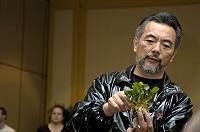 A well aquascaped aquarium grabs our attention. Even those who have shown little or no interest in aquaria will immediately recognize that such a visual display has been carefully crafted. The composer of such a work possesses a refined skill.
A well aquascaped aquarium grabs our attention. Even those who have shown little or no interest in aquaria will immediately recognize that such a visual display has been carefully crafted. The composer of such a work possesses a refined skill.
While we deeply appreciate the final work, and while we realize that the work has been crafted, most of us have no idea how the work is crafted.
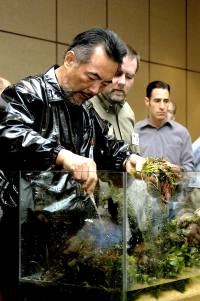
I sat through Amano's two hour demonstration. With a second-row seat I carefully documented the whole presentation with my camera. TFH magazine recently (June 2005) published a sequence of my photos with my narration.
I retell Amano's demonstration here. The sequence of photos and the commentary that follows are not identical to what was published.
Amano's choice of design
This design involves three tiers:
- a foreground arc of fine white sand
- a middle tier of driftwood and low, slow-growing plants
- a densely planted background of fast-growing stem plants that reach the surface.
laying the "ground" work
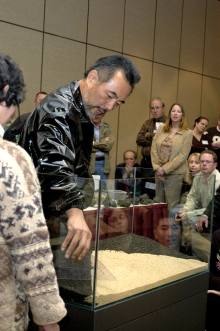
In the photo Amano is carefully applying a finishing touch to this mixed substrate.
building the border
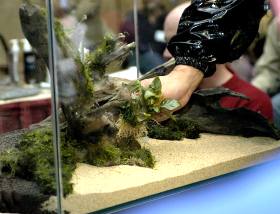
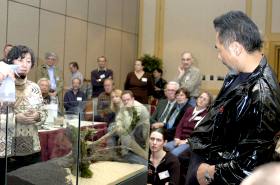
Did you notice that most of this work is being done with very little water in the tank? To keep the plants from dehydrating, they are sprayed frequently with a heavy mist of water. But the arangement of driftwood and these types of plants are better tackled with little-to-no standing water.
a forest in the background
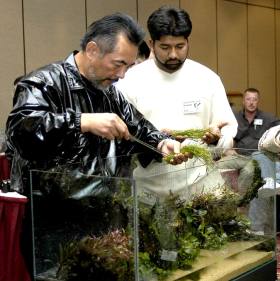 Because stem plants typically grow to the surface, their most common use in the aquascaped aquaria is densely planted in the background.
Because stem plants typically grow to the surface, their most common use in the aquascaped aquaria is densely planted in the background.
Amano has long championed the virtue of using special tools for planting stem plants (as you can see here). Notice the low level of water. The master added this level before starting on the stem plants. A short column of water takes advantage of the stem plant's boyancy -- as the roots are pushed into the substrate the rest of the plant floats. This floating not only makes planting easier, it also enables one to anchor the plants into a dense arrangement.
the master finishes his work...
After all the plants have been anchored, water is slowly pumped into the tank -- very slowly. Even though it is added with an extremely gentle flow, the water appears murky at first. Fine sediment pieces from the substrate float within the water column. Eventually, these dust-sized pieces will settle, and the view will become clear.
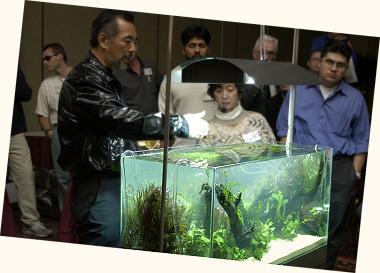 But what you see is the best one can do in a live demonstration.
But what you see is the best one can do in a live demonstration.
Now the master is done creating. At the convention he stands behind his newly birthed work, answering questions.
...but the work needs time to finish
Throughout both of his two-hour presentations, Amano emphasized that an aquascape is not finished once the aquascaper completes his work. The initial planting is just the birth. Live plants grow and thus an aquarium is a dynamic piece of work. The work constantly matures.
When does completion come? Usually months later. And even then, the ever maturing and propagation of plants cause the visual display to evolve over the months of its life. The master aquascaper needs to know not only how to arrange the elements of an aquarium -- he must also understand and anticipate the growth and spreading of the plants over the months that follow the initial aquascaping.